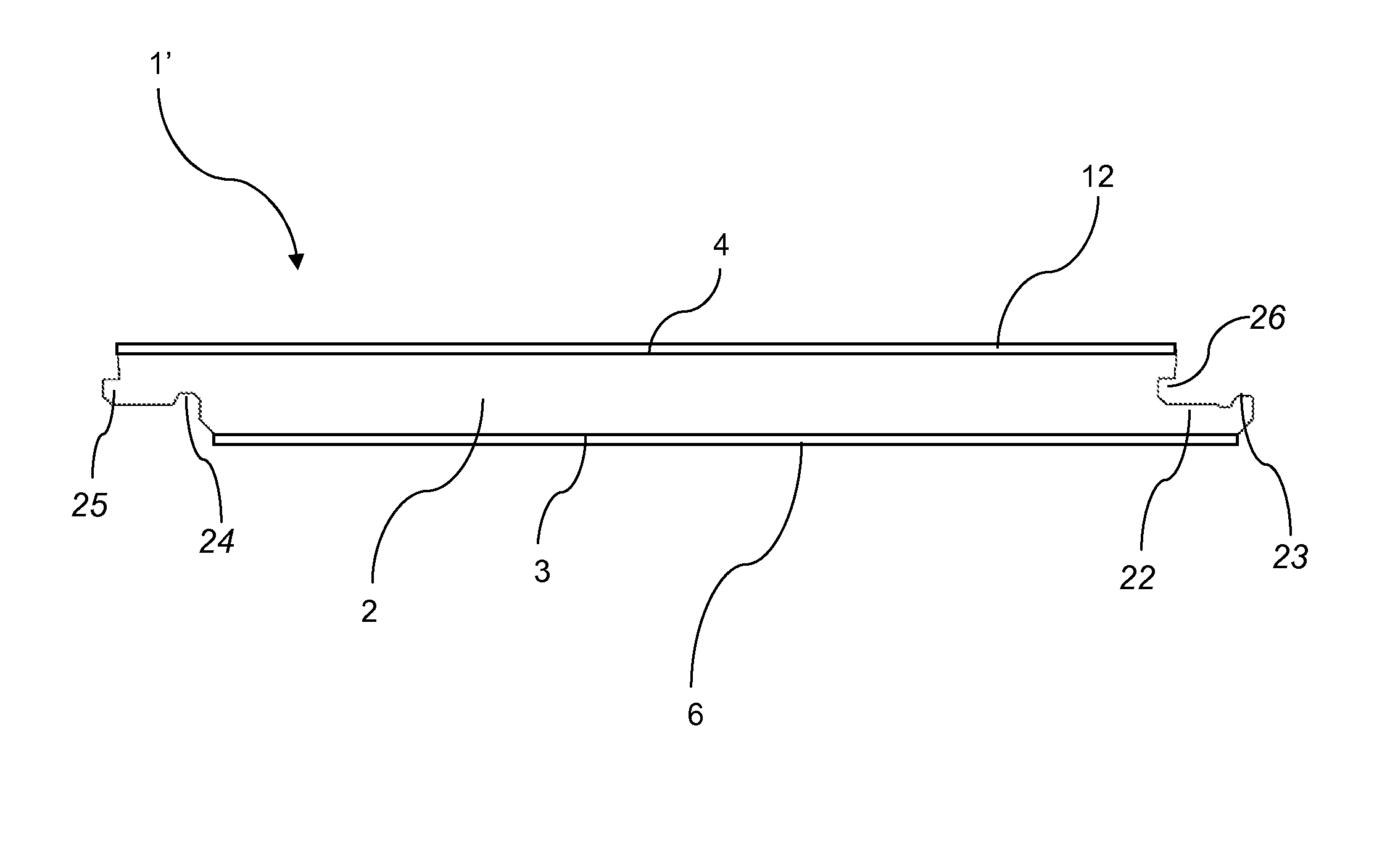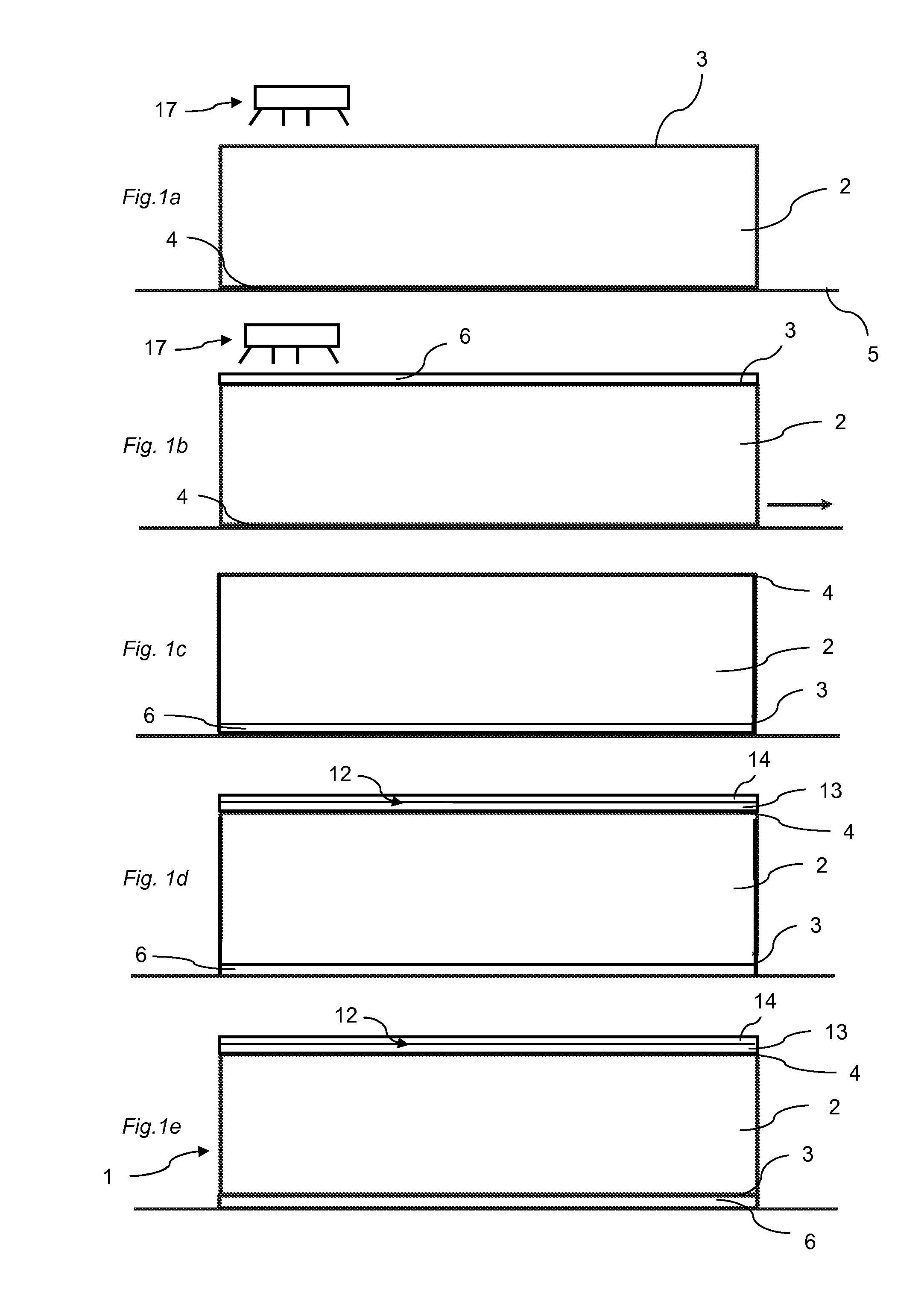Method of producing a building panel and a building panel
a building panel and building panel technology, applied in the field of building panel and building panel production, can solve the problems of inability to take single paper sheets, limited moisture content of conventional backing paper, and essentially flat panel comprising tension forces, so as to reduce the amount of thermosetting binder of the balancing layer, reduce the weight per square meter, and increase shrinkage forces
- Summary
- Abstract
- Description
- Claims
- Application Information
AI Technical Summary
Benefits of technology
Problems solved by technology
Method used
Image
Examples
example 1
Dry Melamine Formaldehyde Resin
[0199]A water solution was sprayed on one surface of a standard HDF board, Sonae 9.7 mm. Then 100 g / m2 melamine formaldehyde powder resin—773 from BASF—was applied with a scattering device on the wet HDF board.
[0200]The HDF board was then turned upside down and a surface layer containing 100 g / m2 melamine formaldehyde resin was applied on the other side of the board.
[0201]The HDF board containing a clean dry melamine formaldehyde resin on one side for forming a balancing layer and on the other side a surface layer containing 100 g / m2 melamine, then was put into a press where heat and pressure was applied.
[0202]Pressing conditions:
[0203]Temperature: 160° C. on the upper and under heating plates.
[0204]Pressing time: 20 sec
[0205]Pressure: 40 bar
[0206]During the pressing operation the melamine formaldehyde resins cured and a laminate board was obtained.
[0207]In order to investigate the cupping behavior of this product we placed the above flooring laminate ...
example 2
Wet Melamine Formaldehyde Resin
[0208]300 g / m2 wet melamine formaldehyde resin with a solid content of 50% was applied with a roller device one surface of a standard HDF board, Sonae 9.7 mm, and then dried in an oven so the surface was dry which gives the possibility to turn the HDF board upside down. A surface layer containing 300 g / m2 melamine formaldehyde resin was applied on the other side of the board.
[0209]The HDF board containing a wet melamine resin on one side for forming a balancing layer and on the other side a surface layer containing 300 g / m2 melamine resin was then put into a press where heat and pressure was applied.
[0210]Pressing conditions:
[0211]Temperature: 170° C. on the upper and under heating plates.
[0212]Pressing time: 30 sec
[0213]Pressure: 40 bar
[0214]During the pressing operation the melamine formaldehyde resins cured and a laminate board was obtained.
[0215]In order to investigate the cupping behavior of this product we placed the above flooring laminate into ...
example 3
Water
[0216]In order to investigate the influence of water, water was added to a top surface layer. A top surface layer containing 100 g / m2 melamine formaldehyde resin was applied on a surface of a standard HDF board, Sonae 9.7 mm. On top of this a layer 15 g / m2 of water was applied with a spraying device. On the opposite surface of the board a surface layer containing 100 g / m2 melamine was applied.
[0217]The board was then put into a press where heat and pressure was applied.
[0218]Pressing conditions:
[0219]Temperature: 170° C. on the upper and under heating plates.
[0220]Pressing time: 30 sec
[0221]Pressure: 40 bar
[0222]During the pressing operation the melamine formaldehyde resins cured and a laminate board was obtained.
[0223]In order to investigate the cupping behavior of this product we placed the above board into different climates. After 3 days in 50% RH climate the cupping was −1.33 mm (concave cupping). After 3 days in 25% RH Climate the cupping was −2.11 mm (concave cupping).
[0...
PUM
| Property | Measurement | Unit |
|---|---|---|
| temperature | aaaaa | aaaaa |
| pressure | aaaaa | aaaaa |
| thickness | aaaaa | aaaaa |
Abstract
Description
Claims
Application Information
 Login to View More
Login to View More - R&D
- Intellectual Property
- Life Sciences
- Materials
- Tech Scout
- Unparalleled Data Quality
- Higher Quality Content
- 60% Fewer Hallucinations
Browse by: Latest US Patents, China's latest patents, Technical Efficacy Thesaurus, Application Domain, Technology Topic, Popular Technical Reports.
© 2025 PatSnap. All rights reserved.Legal|Privacy policy|Modern Slavery Act Transparency Statement|Sitemap|About US| Contact US: help@patsnap.com



